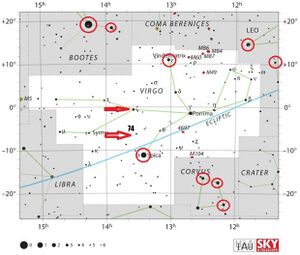Apamvatsa: Difference between revisions
No edit summary |
No edit summary |
||
| Line 1: | Line 1: | ||
{{DISPLAYTITLE:Āpaṃvatsa ()}} |
{{DISPLAYTITLE:Āpaṃvatsa ()}} |
||
[[File:0048 apa and apavatsapaperVII Fig2.jpeg|thumb|The stars identified by Shylaja and Pai (2019), their Table 2, are marked with red circles on the map of Virgo. The two arrows correspond to Apamvatsa and Apa. The original chart by IAU and Sky & Telescope magazine (Roger Sinnott & Rick Fienberg) is from Creative Commons.]]Āpaṃvatsa is an Indian star name attested throughout the last millennium. The only indication of the position is Apamvatsa is 5° to the north of [[Chitra]] ([[Spica]]) in [[Virgo]]. No information on magnitudes is preserved.<ref>B. S. Shylaja and Venketeswara Pai (2019). Āpa and Apāṃvatsa – enigmatic stars catalogued in Sūryasiddhānta, J. Astrophys. Astr. (2019) 40:48, Indian Academy of Sciences</ref> |
[[File:0048 apa and apavatsapaperVII Fig2.jpeg|thumb|The stars identified by Shylaja and Pai (2019), their Table 2, are marked with red circles on the map of Virgo. The two arrows correspond to Apamvatsa and Apa. The original chart by IAU and Sky & Telescope magazine (Roger Sinnott & Rick Fienberg) is from Creative Commons.]]Āpaṃvatsa is an Indian star name attested throughout the last millennium. The only indication of the position is Apamvatsa is 5° to the north of [[Chitra]] ([[Spica]]) in [[Virgo]]. No information on magnitudes is preserved.<ref>B. S. Shylaja and Venketeswara Pai (2019). Āpa and Apāṃvatsa – enigmatic stars catalogued in Sūryasiddhānta, J. Astrophys. Astr. (2019) 40:48, Indian Academy of Sciences</ref> Shylaja and Pai (2019) identify 74 Vir ([https://simbad.cds.unistra.fr/simbad/sim-basic?Ident=74+Vir&submit=SIMBAD+search SIMBAD], [https://vsx.aavso.org/index.php?view=detail.top&oid=44921 VSX]), a red giant of roughly one solar mass. Red giants vary in brightness due to pulsation, but the VSX gives only an interval of 0.07 mag in V. |
||
==Concordance, Etymology, History== |
==Concordance, Etymology, History== |
||
| Line 8: | Line 8: | ||
Spelling Variants: |
Spelling Variants: |
||
Identification Variants: Shylaja and Pai (2019) also discussed the Mira-variable S Vir that reaches V~6.3 mag in peaks, but find it unlikely. Yet, they also conclude that the identification with 74 Vir is highly uncertain. |
|||
=== Origin of Name === |
=== Origin of Name === |
||
Revision as of 17:18, 30 September 2025
Āpaṃvatsa is an Indian star name attested throughout the last millennium. The only indication of the position is Apamvatsa is 5° to the north of Citrā (चित्रा) (Spica) in Virgo. No information on magnitudes is preserved.[1] Shylaja and Pai (2019) identify 74 Vir (SIMBAD, VSX), a red giant of roughly one solar mass. Red giants vary in brightness due to pulsation, but the VSX gives only an interval of 0.07 mag in V.
Concordance, Etymology, History
Translation:
Spelling Variants:
Identification Variants: Shylaja and Pai (2019) also discussed the Mira-variable S Vir that reaches V~6.3 mag in peaks, but find it unlikely. Yet, they also conclude that the identification with 74 Vir is highly uncertain.
Origin of Name
The text Sūryasiddhānta is considered as an authority from the 8th to the 19th century CE, but the author(s) remain unknown. Its date is estimated to the 4th or 5th century. It contains a chapter with lists of coordinates and names of stars, which allows for identifications.
| Author | Date (CE) | Source/ Reference | Coordinates | |
|---|---|---|---|---|
| Dh | Vi | |||
| Aryabhaṭa | 5th century | |||
| Lalla | 5th– 9th century | Śiṣyadhīvṛddhidatantra of Lalla, ed. and tr. by Bina Chatterjee, vol II, INSA, New Delhi, 1981. | ||
| Vaṭeśvara | 10th century | Vaṭeśvarasiddhānta of Vaṭeśvara, critically edited with English translation and commentary, by Shukla K. S., INSA, New Delhi, 1985. | ||
| Śrīpati | 12th century | Siddhāntaśekhara, ed. and tr. by Sripada Bhat (INSA Report, unpublished) | ||
| Sūryasiddhānta | ? | Wilkinson and Bapudeva Sastri, 1861, online digital versions Google books | 5° North of Citrā | |
| Parameśvara | 13th century | Commentary on SS | ||
| Padmanābha Manuscript B number 45892 | 1423 | Yantrarāja-Adhikāra Chapter 1, Yantrakiraṇāvali, Ohashi Y., IJHS, 32.3 (1997) 199–295. | 185|9 | 2|53 |
| Padmanābha Manuscript A 45888 | 1576 (or earlier) | Yantrarāja-Adhikāra Chapter 1, Yantrakiraṇāvali, Ohashi Y., IJHS, 32.3 (1997) 199–295. | 185|9 | 2|53 |
| Ganeśa Daivajña | Grahalāghava, ed. and tr. by Balachandra Rao S. and Uma S. K., 2008. | 183 | 3 | |
| Munīśvara, | 1646 | Siddhāntasārvabhauma of Munīśvara, edited by Pt. Mīthālāla Ojhā, Saṃpurṇānand Sanskrit Vishvavidyalaya, Varanasi, 1978. | 5° North of Citrā | |
| Ketkar | 1855 | Ketakīya Grahagaṇitam | ||
| Candraśekhara Sāmanta | 1864 | Siddhāntadarpaṇa. | 5° North of Citrā | |
Transfer and Transformation
Religion/ Tales/ Mythology
mnemonic tales and cultural significance
Weblinks
References
- References (general)
- ↑ B. S. Shylaja and Venketeswara Pai (2019). Āpa and Apāṃvatsa – enigmatic stars catalogued in Sūryasiddhānta, J. Astrophys. Astr. (2019) 40:48, Indian Academy of Sciences





